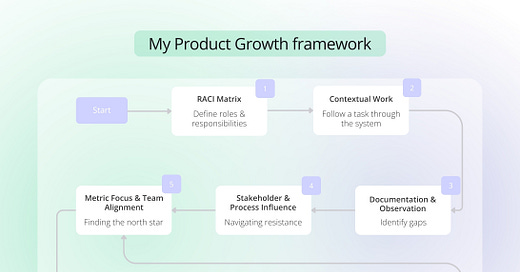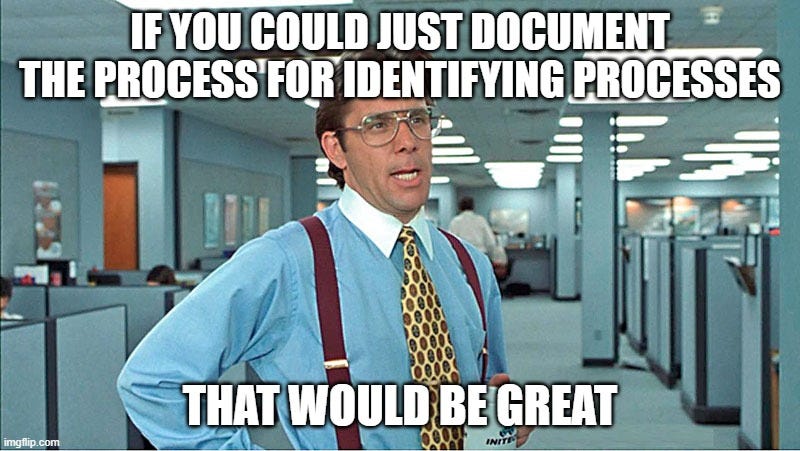My Product Growth framework
How I turn product teams into growth teams (without breaking anything)
Today I want to tell you about growth teams and how I’ve turned a few of them around.
Since I’ve left Booking.com (thankful of the experimentation and stakeholder management experience) and joined Flo — and then other companies — there seems to be a pattern at what I’m best at. I excel growth teams.
With the product manager title, I would come in, and optimize not just the product but also the team structure and the processes. My, do I love optimizing processes — back in 2009 I worked in Germany with a Process team and the epiphany of it was putting together a process for identifying processes.
Back to the growth teams.
It would typically go like this: I would come in, look around, talk to people, see where the bottlenecks and pains are, figure out who the boss is and where the real work gets done, and then get moving. Typically, in 3 to 5 months, it would “suddenly” start working. I like to not disrupt things, but instead slowly and surely drive everyone to row in the same direction, align on the goal, and speed everything up.
The process would go like this:
Identify the team, the stakeholders, and put them all on a RACI matrix.
Contextualize on the work quickly by getting the increment of work to move through the whole current process. Don’t wait until you’re “in full context”—that is too slow. Just grab a task and follow it through all the stages to the best of your ability, learning along the way.
Whatever you do, document it. Use your “fresh eye” perspective to see if something doesn’t make sense. It’s either an opportunity to improve or a chance to learn why it’s the way it is (and then improve it anyway).
Identify the difficult people who don’t want to change, the rigid processes, and gently yet firmly stir them to improve. This one’s hard. It relies on advanced soft skills and takes the most time. I like to spend time in 1:1s with people from step 1, understand their motivations, what drives them, ensure them we’re all here to improve the customers’ lives by delivering valuable product changes and that I’d love to help them get [insert motivation here] and help them do their best work.
Roughly in 2-3 weeks, you start to see that there is one metric that should be the priority — shed the rest and focus on it as a primary metric, and get it to become everyone’s focus -> alignment. You cannot have more than one primary metric, the word ‘priority’ was made up in singular.
Speed up testing. (In)validate hypotheses quickly. I call this “identify the levers.” Basically, touch as much surface area as you can to see where the signal is strongest—then double down there. In Booking, we called it “milking the cow.”
Use Exploration-exploitation mode. It’s where you exploit the areas where the signal is strong and you also spend 10-20% of work time on exploration—looking for new pastures -> more cows to milk when the current one stops yielding. Make sure you exploit the areas where your changes succeed or fail dramatically. In A/B testing language: if it’s red, it’s also good—means there’s a lot of potential to improve.
Then, roughly around month 3, you have a solid foundation, good rapport, a clear mad for where to focus on and you see early results, and have a runway of 4-6 more months until you hit the next stage and have to adapt again.
I like to use Storming-forming-norming-performing framework for this. I would typically turn the team to performing and we would perform and show good results for a few quarters, then we would see our experiment success rate lessen. This happens after ±450 experiments. Then you adjust your methods, break into the new phase and repeat all over.
After having done this a few times and becoming a consultant, I figured this was all common sense, so I double-down on the niche of web onboardings. However, I still find myself getting into processes and optimization beyond funnels (hence the name of this newsletter, btw, please subscribe, thanks).
See results of this approach here and here.
While I’m no longer interested in doing this from the ground up as a full-time employee, I’m always happy to advise teams if they want an outside perspective or a push in the right direction.
Thanks for reading and see you next week for a February RESET (yep, and just like that, February is over, we made it!)






